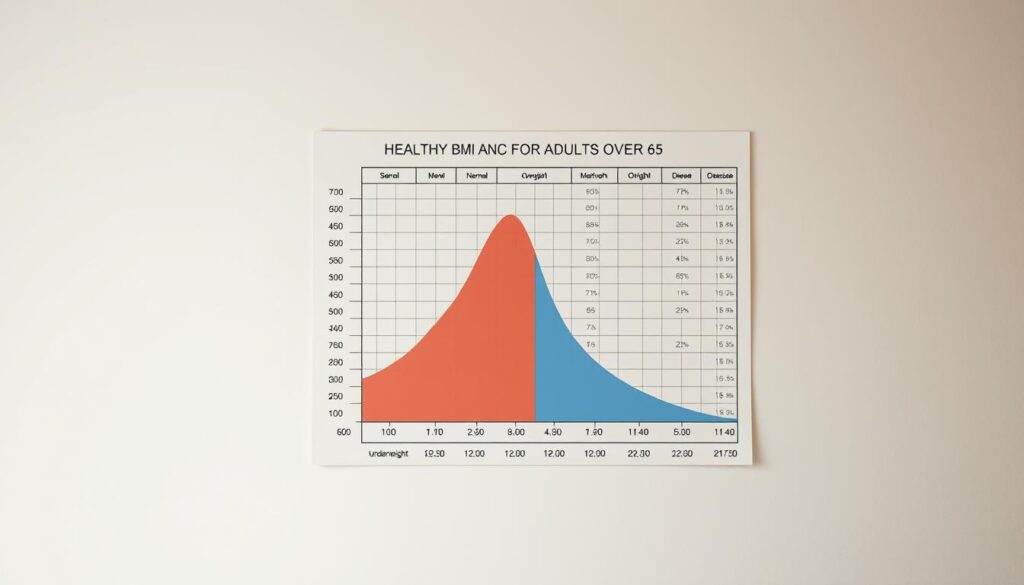As we age, maintaining a healthy weight becomes increasingly important for our overall health and wellbeing. As Jim Rohn once said, “Take care of your body. It’s the only place you have to live.” This quote emphasizes the significance of looking after our physical health, particularly as we grow older.
For adults over 65, a BMI calculator can be a valuable tool in assessing whether their weight is in a healthy range. Unlike standard BMI calculators, our tool is specifically designed to account for the physiological changes that occur in older adults.
Understanding your weight status can help identify potential health risks associated with being underweight or overweight, enabling better-informed decisions about your health.
Key Takeaways
- Our BMI calculator is tailored for adults over 65, considering the unique physiological changes they undergo.
- Traditional BMI ranges may not apply to seniors; our calculator provides more relevant health insights.
- Maintaining a healthy weight is crucial for reducing the risk of various diseases.
- The calculator uses height and weight measurements to determine BMI and the appropriate weight category for older adults.
- Understanding your weight status can help you make informed health decisions.
Understanding BMI for Older Adults
As we age, our bodies undergo significant changes that affect how we measure health, particularly when it comes to Body Mass Index (BMI). BMI is a widely used metric to assess weight status, but its application and interpretation differ among older adults compared to younger populations.
What is BMI and How is it Measured?
BMI is calculated by dividing a person’s weight in kilograms by their height in meters squared. This measurement serves as a screening tool to categorize individuals into various weight status categories.
Although the calculation remains the same across adults, the interpretation of BMI varies significantly with age. For instance, a higher BMI in older adults may not carry the same health risks as it does in younger individuals.
Why Standard BMI Guidelines Don’t Apply to Seniors
Traditional BMI guidelines were developed based on studies of younger populations and do not account for the natural changes in body composition that occur with aging, such as decreased muscle mass and increased body fat.
For seniors over 65, standard BMI categories can be misleading because older adults naturally have different body compositions. According to a study published on Verywell Health, being overweight is not associated with an increased risk of mortality in older populations.
| Age Group | BMI Range | Health Implications |
|---|---|---|
| Younger Adults | 18.5-24.9 | Normal weight |
| Older Adults | 23-29.9 | Associated with better health outcomes |
BMI Calculator for Seniors Over 65
As we age, our body composition changes, making a senior-specific BMI calculator an invaluable tool for health monitoring. Our BMI calculator for seniors is designed to provide a more accurate assessment of healthy weight, considering the unique factors that come into play after the age of 65.
How to Use Our Senior BMI Calculator
Using our BMI calculator is straightforward. Simply enter your height and weight in either metric or imperial units, and our tool will automatically calculate your BMI and categorize it according to senior-specific guidelines.
Our calculator features a built-in unit converter, so you don’t need to worry about manual conversions. This makes it easy to get your BMI result regardless of the units you’re familiar with.
Interpreting Your Results
Once you’ve used our calculator, your BMI result will be displayed along with your weight category, specifically adjusted for seniors over 65. The categories include underweight (BMI below 23), normal weight (BMI 23-29.9), and overweight/obese (BMI 30 and above).
Understanding your BMI category is crucial because it provides insights into potential health implications. For instance, being underweight can indicate a higher risk of osteoporosis, while being overweight can increase the risk of chronic diseases like diabetes and heart disease.
Here are some key points about using and understanding our BMI calculator for seniors:
- Our BMI calculator uses the standard BMI formula but interprets results using age-appropriate categories.
- The calculator automatically categorizes your BMI according to senior-specific guidelines after you input your height and weight.
- Your BMI result will be displayed along with your weight category, adjusted for seniors over 65.
- Understanding your results is crucial for assessing potential health implications.
- Remember, BMI is just one health indicator and should be considered alongside other factors like muscle mass and activity level.
Healthy BMI Ranges for Adults Over 65
For older adults, the concept of a healthy BMI differs significantly from that of younger populations. As people age, their body composition changes, including a decrease in muscle mass and an increase in body fat, even if their weight remains stable.
Extensive research has led to the establishment of different BMI categories for older adults. A healthy weight for adults over 65 is now defined as a BMI ranging from 23 to 29.9 kg/m², unlike the standard adult range of 18.5 to 24.9 used for younger populations.
Geriatric BMI Categories Explained
The healthy BMI range for adults over 65 is between 23 and 29.9. This range is based on observations that seniors with slightly higher body mass tend to have better health outcomes and lower mortality rates than those with lower BMI values. Being underweight (BMI below 23) poses serious health risks, including increased mortality and frailty.
To understand your BMI category, you can use our geriatric BMI calculator. This tool helps you quickly identify your category and understand the associated health implications.
BMI Chart for Seniors
Our comprehensive BMI chart for seniors provides a visual reference to understand the different categories. The chart categorizes BMI into various ranges, helping you identify whether you are underweight, at a healthy weight, or overweight.
| BMI Category | BMI Range | Health Risk |
|---|---|---|
| Underweight | Below 23 | High |
| Healthy Weight | 23-29.9 | Low |
| Overweight/Obese | 30 and above | High |
Health Implications of BMI in Older Adults
The health implications of BMI in older adults are multifaceted and warrant careful consideration. As we age, our body composition changes, with shifts in muscle mass, bone density, and body fat distribution. These changes can affect our overall health and increase the risk of various health conditions.
Advantages of a Higher BMI
A higher BMI in seniors can have several benefits. Research suggests that maintaining a slightly higher BMI (between 25 and 27) can provide several health benefits, including better nutritional reserves, improved cognitive function, and greater social functioning.
- Improved nutritional state and energy reserves
- Better cognitive function and emotional health
- Greater social functioning and independence
Risks Associated with Being Underweight or Overweight
While a higher BMI can have its benefits, being underweight or overweight also carries significant risks. Being underweight (BMI below 23) can lead to frailty, reduced immune function, and slower recovery from illness. On the other hand, extreme obesity can increase the risk of heart disease and diabetes.
Risks of being underweight:
- Frailty and reduced immune function
- Slower recovery from illness and higher hospitalization rates
Risks of being overweight:
- Increased risk of heart disease and diabetes
- Potential for reduced mobility and independence
Maintaining a Healthy Weight After 65
Seniors over 65 require a different approach to weight management, focusing on nutrition quality rather than just calorie restriction. As we age, our bodies undergo various changes that affect our weight and overall health.
Nutritional quality is paramount for seniors. It’s not just about cutting calories, but ensuring that the diet is rich in essential nutrients. This includes consuming foods with a high calorie-to-volume ratio, such as nuts, nut butters, avocados, and full-fat dairy products.
For underweight seniors, weight gain strategies should emphasize nutrient-dense foods that provide vital vitamins, minerals, and protein to support muscle maintenance and overall health. It’s also crucial to eat more frequently, having five to six smaller meals per day.
Protein intake is critical for preserving muscle mass and preventing sarcopenia. Seniors should aim for approximately 1 gram of protein per kilogram of body weight daily. Regular physical activity, particularly strength training, also plays a vital role in maintaining muscle mass and bone density.
Before making any significant dietary changes, it’s essential to consult with healthcare providers, as weight fluctuations in seniors can sometimes indicate underlying health conditions. For those who need to gain weight, focusing on nutrient-dense, calorie-rich foods is recommended.
Remember, BMI is just one health indicator. Factors like muscle mass, activity level, and existing health conditions should all be considered when assessing your ideal weight after 65. By taking a holistic approach to health and working with healthcare professionals, seniors can maintain a healthy weight and reduce the risk of various health problems.



